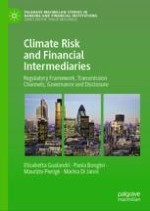2024 | OriginalPaper | Buchkapitel
4. Integrating Climate Risk into Commercial Banks Operations
verfasst von : Elisabetta Gualandri, Paola Bongini, Maurizio Pierigè, Marina Di Janni
Erschienen in: Climate Risk and Financial Intermediaries
Verlag: Springer Nature Switzerland
Aktivieren Sie unsere intelligente Suche, um passende Fachinhalte oder Patente zu finden.
Wählen Sie Textabschnitte aus um mit Künstlicher Intelligenz passenden Patente zu finden. powered by
Markieren Sie Textabschnitte, um KI-gestützt weitere passende Inhalte zu finden. powered by
